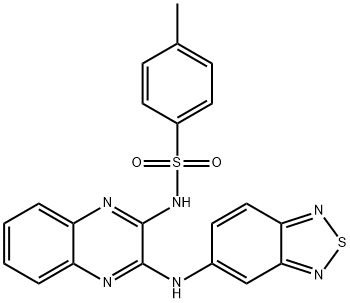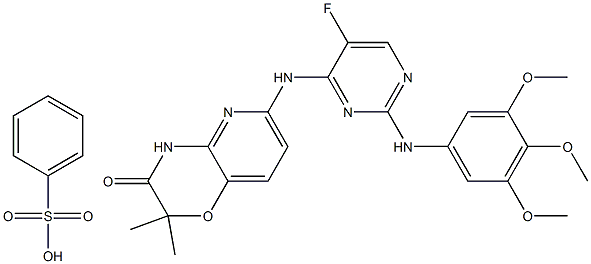PIK-93
Synonym(s):N-(5-(4-Chloro-3-(((2-hydroxyethyl)amino)sulfonyl)phenyl)-4-methyl-2-thiazolyl)-acetamide;PI 3,4-K inhibitor, PIK-93 - CAS 593960-11-3 - Calbiochem;PIK-93
- CAS NO.:593960-11-3
- Empirical Formula: C14H16ClN3O4S2
- Molecular Weight: 389.88
- MDL number: MFCD12922510
- SAFETY DATA SHEET (SDS)
- Update Date: 2024-11-19 23:02:33

What is PIK-93?
Description
PIK-93 is an inhibitor of phosphatidylinositol 4-kinase IIIβ (PI4KIIIβ; IC50 = 19 nM). It is selective for PI4KIIIβ over PI4KIIIα and PI4KIIα (IC50s = 1,100 and >100,000 nM, respectively). However, it also inhibits the PI3K catalytic subunits (IC50s = 39, 590, 120, and 16 nM for p110α, p110β, p110δ, and p110γ, respectively). PIK-93 reduces enteroviral RNA replication when used at a concentration of 125 nM in HeLa cells. It also inhibits the transport of ceramide from the endoplasmic reticulum to the Golgi apparatus.
The Uses of PIK-93
PIK 93 is a PI3Kγ and PI4KIIIβ inhibitor.
What are the applications of Application
PIK-93 is a novel and potent inhibitor
Enzyme inhibitor
This potent and selective PI3Kγ/PI4KIIIβ inhibitor (FW = 389.88; CAS 593960-11-3; Solubility (25°C): 78 mg/mL DMSO, <1 mg/mL Water), also known as N-[5-[4-chloro-3-[(2-hydroxyethyl)sulfamoyl]phenyl]-4- methylthiazol-2-yl]acetamide, impairs actin filament consolidation and stability at the leading edge in cells treated with N-formyl-Met-Leu-Phe as well as ceramide transport between ER and Golgi compartments. The inhibition of PI3K by PIK-93, LY294002, or wortmannin decreased carbachol-induced translocation of TRPC6 to the plasma membrane and carbachol-induced net Ca2+ entry into T6.11 cells. PIK-93 inhibits both poliovirus (PV) and hepatitis C virus (HCV) replication, with EC50 values of 0.14 μM and 1.9 μM, respectively. Targets: PI3Kγ, IC50 = 16 nM; PI4KIIIβ, IC50 = 19 nM; PI3Kα, IC50 = 39 nM; PI3Kδ, IC50 = 0.12 μM; and PI3Kβ, IC50 = 0.59 μM.
References
[1] monet m, francoeur n, boulay g. involvement of phosphoinositide 3-kinase and pten protein in mechanism of activation of trpc6 protein in vascular smooth muscle cells. j biol chem. 2012 may 18;287(21):17672-81.
[2] tóth b, balla a, ma h et al. phosphatidylinositol 4-kinase iiibeta regulates the transport of ceramide between the endoplasmic reticulum and golgi. j biol chem. 2006 nov 24;281(47):36369-77.
[3] hsu, n. y., et al. 2010. viral reorganization of the secretory pathway generates distinct organelles for rna replication. cell 141:799-811.
[4] arita m, kojima h, nagano t et al. phosphatidylinositol 4-kinase iii beta is a target of enviroxime-like compounds for antipoliovirus activity. j virol. 2011 mar;85(5):2364-72.
Properties of PIK-93
| storage temp. | 2-8°C |
| solubility | DMSO: soluble15mg/mL, clear |
| form | powder |
| color | white to beige |
| CAS DataBase Reference | 593960-11-3 |
Safety information for PIK-93
Computed Descriptors for PIK-93
| InChIKey | JFVNFXCESCXMBC-UHFFFAOYSA-N |
New Products
Tert-butyl bis(2-chloroethyl)carbamate 4-Methylphenylacetic acid N-Boc-D-alaninol N-BOC-D/L-ALANINOL N-octanoyl benzotriazole 3-Morpholino-1-(4-nitrophenyl)-5,6-dihydropyridin- 2(1H)-one Furan-2,5-Dicarboxylic Acid DIETHYL AMINOMALONATE HYDROCHLORIDE 1,1’-CARBONYLDIIMIDAZOLE R-2-BENZYLOXY PROPIONIC ACID 1,1’-CARBONYLDI (1,2-4 TRIAZOLE) N-METHYL INDAZOLE-3-CARBOXYLIC ACID (2-Hydroxyphenyl)acetonitrile 4-Bromopyrazole 5-BROMO-2CYANO PYRIDINE 5,6-Dimethoxyindanone 5-broMo-2-chloro-N-cyclopentylpyriMidin-4-aMine 2-(Cyanocyclohexyl)acetic acid 4-methoxy-3,5-dinitropyridine 1-(4-(aminomethyl)benzyl)urea hydrochloride 2-aminopropyl benzoate hydrochloride diethyl 2-(2-((tertbutoxycarbonyl)amino) ethyl)malonate tert-butyl 4- (ureidomethyl)benzylcarbamate Ethyl-2-chloro((4-methoxyphenyl)hydrazono)acetateRelated products of tetrahydrofuran
![4H-PYRIDO[1,2-A]PYRIMIDIN-4-ONE, 7-METHYL-2-(4-MORPHOLINYL)-9-[1-(PHENYLAMINO)ETHYL]-](https://img.chemicalbook.in/CAS/GIF/663619-89-4.gif)





![N-(2,3-Dihydro-7,8-dimethoxyimidazo[1,2-c]quinazolin-5-yl)-3-pyridinecarboxamide](https://img.chemicalbook.in/CAS/GIF/677338-12-4.gif)

You may like
-
 N-(5-(4-Chloro-3-(((2-hydroxyethyl)amino)sulfonyl)phenyl)-4-methyl-2-thiazolyl)-acetamide 98.00% CAS 593960-11-3View Details
N-(5-(4-Chloro-3-(((2-hydroxyethyl)amino)sulfonyl)phenyl)-4-methyl-2-thiazolyl)-acetamide 98.00% CAS 593960-11-3View Details
593960-11-3 -
 PIK-93 >95% CAS 593960-11-3View Details
PIK-93 >95% CAS 593960-11-3View Details
593960-11-3 -
 PIK93 CAS 593960-11-3View Details
PIK93 CAS 593960-11-3View Details
593960-11-3 -
 1975-50-4 98%View Details
1975-50-4 98%View Details
1975-50-4 -
 2-HYDROXY BENZYL ALCOHOL 98%View Details
2-HYDROXY BENZYL ALCOHOL 98%View Details
90-01-7 -
 14714-50-2 (2-Hydroxyphenyl)acetonitrile 98+View Details
14714-50-2 (2-Hydroxyphenyl)acetonitrile 98+View Details
14714-50-2 -
 118753-70-1 98+View Details
118753-70-1 98+View Details
118753-70-1 -
 733039-20-8 5-broMo-2-chloro-N-cyclopentylpyriMidin-4-aMine 98+View Details
733039-20-8 5-broMo-2-chloro-N-cyclopentylpyriMidin-4-aMine 98+View Details
733039-20-8